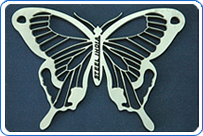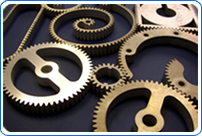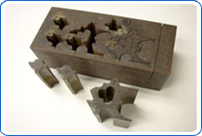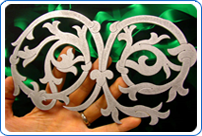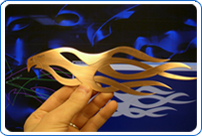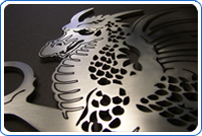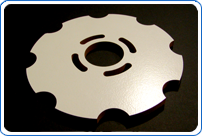Water Jet Versus Other Machining Processes
|
| |
| Comparing abrasive waterjet to wire EDM |
| |
|
| Key Wire EDM strengths |
| |
» Extremely precise parts are possible [+0.0001” (+0.025 mm)] |
| |
» Very thick parts [ocer 12’ (30 cm)] can be made |
| |
» Intentional taper can be put into a part for die clearance and other uses |
| Key Precision abrasive waterjet strengths |
|
| |
» Five to ten times faster in parts less than 1” (2.5 cm) thick [but, at + 0.003” (0.1 mm), less precise as well] |
| |
» No Heat Affected Zone (HAZ), so no need for secondary operations to remove the HAZ or additional heat-treating to compensate for it |
| |
» Works well in non-conductive materials (such as glass, stone, plastic) as well as conductive materials |
| |
» Can product large parts at reasonable costs |
| |
|
| Comparing abrasive waterjet to laser |
|
| |
|
|
| Key Wire Laser strengths |
|
| |
» Very fast production in thin, non-reflective materials such as sheet steel. |
| |
» Accuracy to +0.001” (+0.025 mm) or better in thin material |
| Key Precision abrasive waterjet strengths |
| |
» Can produce parts up to 2” (5.1 cm) thick in virtually any material while holding tolerances on the order of +0.003” to +0.005” (+0.08 to +0.1 mm). |
| |
» Can machine reflective, conductive and thicker materials such as stainless steel and aluminum, copper, brass etc.. |
| |
» Cuts without melting, providing a smooth uniform surface with very little burr or dross. |
| |
» No heat-affected zone (HAZ), which may eliminate the need for a secondary operation to remove HAZ and makes conventional secondary operations, such as reaming or tapping, easier to perform. |
| |
| Comparison of precision abrasive waterjet to milling |
| |
|
|
| Key mill or machining center strengths |
|
| |
» A well-understood familiar technology |
| |
» Able to make three-dimensional parts |
| |
» Rapid production if set up and programmed for long-run parts |
| Key precision abrasive waterjet strengths |
| |
» Very low cutting loads means that fixturing is easier and also means that intricate and delicate parts can be machined |
| |
» Minimal burr compared to conventional machining |
| |
| Comparison of precision abrasive waterjet to punch press |
| |
|
|
| Key punch press strengths |
| |
» A well-understood familiar technology |
| |
» Rapid production in thin material once the machine is properly programmed and set-up |
| |
» Relatively low capital cost (although tooling costs can add up) |
| Key precision abrasive waterjet strengths |
| |
» No distortion of closely spaced parts |
| |
» Minimal burr |
| |
» Ability to work in a wide range of thickness, from sheet metal to plate |
| |
» Ability to work in a very wide range of materials |
| |
|
| Comparison of precision abrasive waterjet to high-definition plasma |
|
| |
|
|
| Key strengths of high-definition plasma |
|
| |
» Relatively low capital costs |
| |
» Very rapid production rates in thin sheet metal, once properly set up and programmed |
| Key Precision abrasive waterjet strengths |
| |
» No melting or heat-affected zone, so no heat distortion or crusted area to impair secondary machining processes such as tapping holes |
| |
» Wider range of material capabilities |
| |
» Wider range of thickness capabilities |
| |
» Better precision in intricate parts |
| |
|
